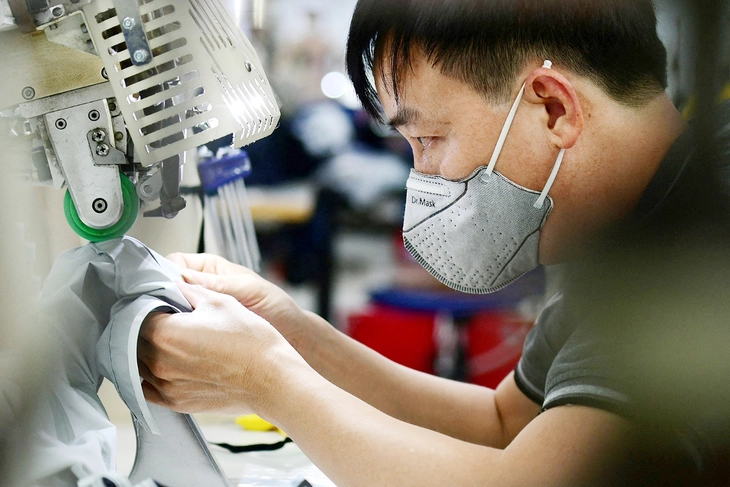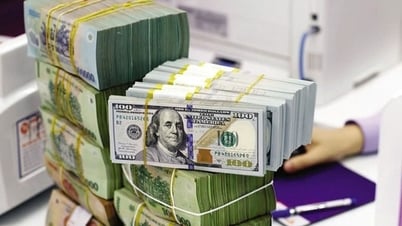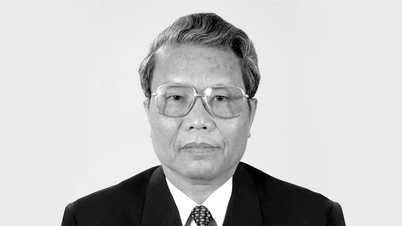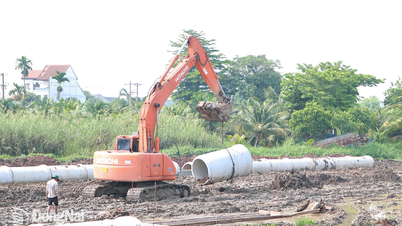Workers at a garment factory in Hanoi - Photo: AFP
It is difficult to know how these tariff negotiations will pan out, but I expect the negotiations between the two sides to bring the tariff on Vietnam down to a level less extreme than 46%.
US tariffs: Many paradoxes
There are many problems and paradoxes in the current approach of the Trump administration.
President Trump doesn't like trade deficits, especially the goods trade deficit, even though the service sector accounts for nearly 90% of the US economy . He wants to see manufacturing return to the US.
In my opinion, the shrinking of US manufacturing is partly due to the “unfair” trade practices that Mr. Trump mentions, but much of this stems from the fact that the US dollar is a reserve currency. Central banks and commercial banks buy US bonds for safety and liquidity, which creates capital flows into the US. This capital (and other US assets) has served to finance the US deficit.
Capital flows into the US increase the value of the USD, thereby making imports into the US cheaper, while US exports to other markets become more expensive, due to the exchange rate difference.
So if the dollar were no longer a reserve currency, most trade deficits would disappear, but the US would then need to maintain high interest rates and low fiscal deficits. This could slow economic growth.
In the current uncertain environment, businesses will need time to see whether Washington's tariffs will be maintained.
Even if companies think tariffs will stick, building factories, developing an ecosystem of suppliers, and training workers will take years. Meanwhile, Americans will pay more for imported goods, and so will importers.
I think there are many problems and paradoxes in Mr. Trump's current approach.
Solutions for Vietnam
Regarding the issue of tariff negotiations between Vietnam and the US, I think that flexible and practical people from the US government are participating in tariff negotiations with Vietnam.
It is difficult to know how these negotiations will pan out, but the expectation is that tariffs will be brought down to a less extreme level than the 46% that Trump announced on April 2 but postponed for 90 days. If Vietnam were to have tariffs similar to those of Indonesia, India or Bangladesh, at around 10-15%, Vietnam’s export growth would not be paralyzed but could slow down.
I think Vietnam should diversify its markets, reducing its dependence on both China (imports) and the US (exports), but that is not easy. Vietnam is gradually becoming a country without cheap labor. The key solution here is to pursue alternative export advantages: improving quality control, production scale and on-time delivery of Vietnamese companies serving foreign investors.
Even as export growth slows, gaining a larger share of the value chain will help domestic manufacturing and GDP growth continue to move forward. This approach will also help Vietnamese businesses improve their capabilities, while becoming more flexible and resilient.
A full-blown trade war between the US and China would be bad for both economies and the global economy. As the US imports fewer Chinese goods, Beijing will look to export them to other countries. The resulting flood of cheap Chinese goods would overwhelm many domestic companies trying to compete. It would be a chaotic situation with few rules, reminiscent of the 1930s.
I think both the US and China will move towards negotiations. For example, Mr. Trump recently announced that he would exempt some electronic products from import tariffs from other countries, including China. This clearly happened in the context of negotiations. Predicting the next developments is very difficult.
Trump signals to ease US-China trade war
Amid tensions between the US and China over retaliatory tariffs each side imposed on the other exceeding 100%, US President Donald Trump has repeatedly claimed in recent days that there have been negotiations between Washington and Beijing. "We've had a lot of good talks with China. It's been really good," Trump told reporters at the White House on April 18 (US time).
A day earlier, Mr. Trump also signaled a possible end to the tit-for-tat tariff hikes between the two sides, admitting that he did not want prices to rise because of tariffs to the point where people would stop buying goods.
On the same day, Mr. Trump affirmed that Washington expected to reach a "very good" trade agreement with China but did not provide details.
The Trump administration announced on April 11 that it would exempt certain electronics and semiconductors, including those originating from China, from tariffs. The United States and China currently impose tariffs on each other’s imports at 145% and 125%, respectively. Some Chinese products are even subject to tariffs totaling 245%.
Commenting in the New York Times, Mr. Paul Ashworth, chief North American economist of Capital Economics, said this move "represents a partial de-escalation in President Trump's trade war with China".
Read moreBack to Topic Page
PROFESSOR DAVID DAPICE - NGHI VU
Source: https://tuoitre.vn/thue-quan-my-bien-nguy-thanh-co-cho-viet-nam-20250420070818637.htm




![[Photo] Anh Hoang - Dinh Duc successfully defended the men's doubles championship of the National Table Tennis Championship of Nhan Dan Newspaper](https://vphoto.vietnam.vn/thumb/1200x675/vietnam/resource/IMAGE/2025/5/23/d6ab3bcac02c49928b38c729d795cac6)

![[Photo] Top players gather at the 2025 Nhan Dan Newspaper National Table Tennis Championship](https://vphoto.vietnam.vn/thumb/1200x675/vietnam/resource/IMAGE/2025/5/23/9ad5f6f4faf146b08335e5c446edb107)

























































































Comment (0)